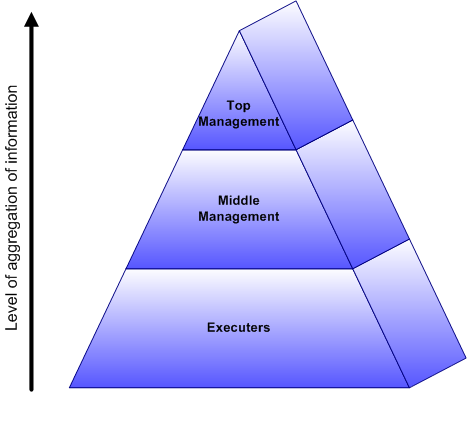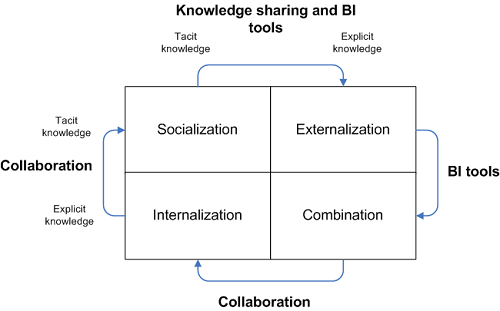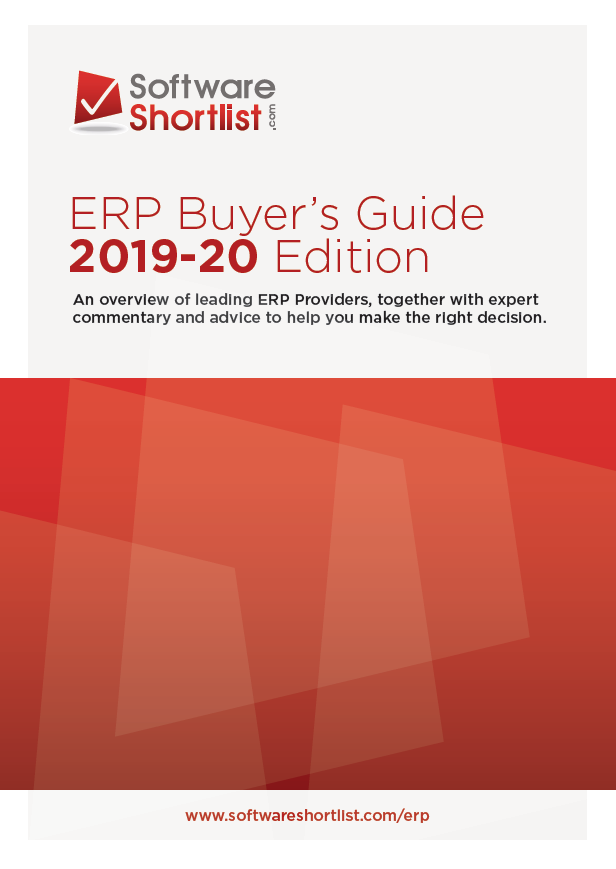The verb “to decide” derives from the Latin word “recidere”, that means “to chop off”. To decide means choosing a thing and chopping the rest. The combination of many decisions all together defines your corporate direction, or in other words, your strategy.
Making effective decisions in a business context requires data, information and knowledge that can be found inside and outside organizations. The information has to be organized to become useful: that’s the role of information systems. They create a complex system, most of the time aided by software, to organize and categorize knowledge and information. They select information from inside and outside the organization and process it.
We should make a distinction: information systems are a completely different thing from the software that elaborates this information. In fact, information systems are all about processes, procedures and people. Directly under this level, we can find the software commonly used to produce useful information from disorganized data: Business Intelligence tools. BI tools collect data from various sources into enormous database and process them into “reports” that can be more or less aggregated.
A lot of theories suggest that information is an essential tool to make better decisions. They even came to correlate the “aggregation” of information with the hierarchy level of decision makers. This pyramid shows a typical organization from a theory perspective: at the top the decision ‘’the makers’’ and at the bottom the “the executers”.
Following the chart, top management typically uses less structured and less organized information. Going down to hierarchy, information become more detailed, more easily structured. The chart represents an ideal situation, where information could always be “rationalized” and used to support decisions. In practice, information could be “rationalized” only in part, and the rest will never be processed. For this reason, I think that classification should be improved. There are some important things we should consider when we talk about information and decisions: (1) that we are not the perfect decision makers that the theory depict and (2) the importance of the “everyday” decisions in shaping your business strategy.
Individual ability to make good decisions
We are not completely rational processing boxes. Our decision process is a matter of unconsciousness and experience: two important elements that take the information we have (not all information, only the ones we consider useful for our internal working) and get to a decision. Neuro-Linguistic Programming, a practice widely used for personal improvement, represents clearly this process: we are governed by automated behaviours, and in most cases we are not even aware of them. These automated behaviours are acquired during the years, through the experience we have made. We are constantly re-using them in our life.
NLP demonstrates that all the information we acquire is filtered through our personal vision of external reality. In this case, the final result of the decision process cannot be considered “perfect” by an objective mean: we can only say that it is the best decision we can do, considering our internal workings, past experience and information at our disposal. Our thinking process, potentially, is far more important than the information we have at our disposal. We have to take into account that rationalized information is only a part of the entire process.
Business strategy and decision-making
I think that strategy is not about a “big decision” and a lot of “small decisions”: it’s better defined as a vision of reality and a direction where to point the organization. In this context, top management creates a “business culture” where all business decisions fit. Business culture has to go “down” the hierarchal pyramid, involving and guiding workers at all levels. We can see that every decision has a background, and that background is necessary to maintain ‘’the right ‘’ company direction and values. Take as an example the “Don’t be evil” motto of Google: it’s business culture, and supposedly every decision at every level should significantly consider that phrase. This approach calls into question the classical view of hierarchal organization: in every level and in every context, everyone becomes potentially a “decision makers”, and this eliminates the concept of “doers”. The information should be available at every level, specialized for the range of tasks that the workers has to do and no longer divided into aggregated and non-aggregated.
The role of BI tools and collaboration software
Information has value, and the organization that builds an infrastructure capable of processing large amount of information coming from various sources, has certainly a better tool to improve efficiency and effectiveness. Reports, produced from collected data, create the possibility to know more about external world and how things are changing: in a context where business has to adapt constantly to market variations, it is essential to implement good business intelligence (BI) tools.
BI tools provide an efficient way to organize the information that can be rationalized, or, in other words, that you can write down. Tacit knowledge, or knowledge that cannot be formalized, remains excluded. For this reason, it’s not a good move to rely only on BI tools if you want to know how the facts are inside and outside the organization. We exposed this concept before: we have to consider also our vision of reality and our unconscious way of resolve problems.
This is a scheme taken from the work of two famous organizational scientists, Nonaka and Takeuchi, enriched with consideration of BI and collaboration tools:
This scheme could also represent a workflow that depict passages from explicit rationalized knowledge to tacit knowledge, and then again to the explicit one. Every step can be assisted by a software: Business Intelligence in the case of externalization to combination route and collaboration/knowledge sharing software in the other phases.
In other words, we should expand our view through sharing and collaboration. I know it could sound rather simplistic, but in most cases it’s the best thing we can do to make better decisions. We should start from the assumption: what we know is a filtered representation of reality, and we should not take decisions (especially the most important ones) based only on that filter.
In this context, alongside BI tools we should integrate collaboration tools in the decision process. We could imagine a continuous workflow, where data analysis is accompanied by sessions of sharing and collaboration. Every decision should be the result of these two steps, and we should find the limit where to stop to analyze data and start to talk about our view and share it with the others.
References:Nonaka, Ikujiro; Takeuchi, Hirotaka (1995), The knowledge creating company: how Japanese companies create the dynamics of innovation, New York: Oxford University Press, pp. 284, ISBN 9780195092691





